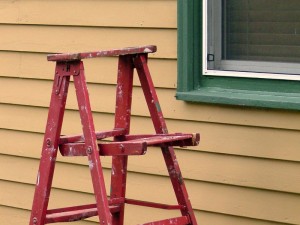Lead Paint Removal: Options and Costs
Originally Published: March 25, 2011
If testing reveals the presence of lead-based paint in your pre-1978 home, here are a few of the options at your disposal for removing it.
What does it cost?
According to the EPA, professional lead-based paint removal for the following three options costs about $8 to $15 per square foot or about $9,600 to $30,000 for a 1,200- to 2,000-sq. ft. house. The average removal project costs about $10,000.
Lead paint removal options
Encapsulation. Typically the least complicated and most affordable method, encapsulation involves brushing or rolling on a specially made paint-like coating that creates a watertight bond and seals in the lead-based paint. However, opening and closing your doors and windows eventually may wear off the coating.
Encapsulation products start at about $35 per gallon. Expect to pay $600 to $1,000 to cover surfaces in a 1,200- to 2,000-sq. ft. home (not including labor).
Enclosure. With this method, the old surface is covered with a new one, such as putting up new drywall or covering windowsills with aluminum or vinyl cladding. If the enclosed surface is ever removed, you’ll have to deal with the exposed lead-containing surfaces underneath.
Removal. A variety of approaches are used to remove lead-based paints, such as wire brushing or wet hand scraping with liquid paint removers. Your contractor may opt to wet sand surfaces, and must use an electric sander equipped with a high-efficiency particulate air (HEPA) filtered vacuum. Another option is stripping off paint with a low-temperature heat gun, and hand scraping.
Forbidden methods of removal include open flame burning or torching, machine sanding without a HEPA attachment, abrasive blasting, and power washing without a means to trap water and paint chips.
Replacement. This more radical strategy calls for taking out the offending surfaces or features and installing new windows, doors, woodwork, and other surfaces.
The do-nothing option
If lead-based paint in your home is in good condition–no chipping or other damage–and no children under the age of 6 live there or visit regularly, you may safely opt to leave the paint untouched. You will need to disclose the presence of the paint if you decide to sell.
However, if the paint is peeling or chipping, or if intact lead-based paint is on window sills and stair rails and children under 6 are present, begin with a cleanup and find out how lead-based paint is regulated by your regional EPA office.
DIY cleanup
Even before lead paint removal occurs, minimize your family’s exposure:
- Clean up paint chips immediately.
- Clean floors, window frames and sills, and other surfaces weekly with warm water and all-purpose cleaner. Thoroughly rinse sponges and mop heads.
- Wash children’s hands often, especially before meals, naps, and bedtime.
- Prevent children from chewing painted surfaces, such as window sills.
- Remove shoes to avoid tracking lead-contaminated soil inside.
For additional information, contact the National Lead Information Center (NLIC).
With four home renovations to her credit, Jan Soults Walker is a devotee of improvements, products, and trends for the home and garden. For 25 years she’s written for a number of national home shelter publications, and has authored 18 books on home improvement and decorating.
Visit houselogic.com for more articles like this. Reprinted from HouseLogic with permission of the NATIONAL ASSOCIATION OF REALTORS. Copyright 2011. All rights reserved.
Category: Sellers


